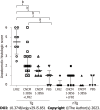Saccharomyces cerevisiae prevents postoperative recurrence of Crohn's disease modeled by ileocecal resection in HLA-B27 transgenic rats
- PMID: 36816618
- PMCID: PMC9932430
- DOI: 10.3748/wjg.v29.i5.851
Saccharomyces cerevisiae prevents postoperative recurrence of Crohn's disease modeled by ileocecal resection in HLA-B27 transgenic rats
Abstract
Background: Postoperative recurrence (POR) after ileocecal resection (ICR) affects most Crohn's disease patients within 3-5 years after surgery. Adherent-invasive Escherichia coli (AIEC) typified by the LF82 strain are pathobionts that are frequently detected in POR of Crohn's disease and have a potential role in the early stages of the disease pathogenesis. Saccharomyces cerevisiae CNCM I-3856 is a probiotic yeast reported to inhibit AIEC adhesion to intestinal epithelial cells and to favor their elimination from the gut.
Aim: To evaluate the efficacy of CNCM I-3856 in preventing POR induced by LF82 in an HLA-B27 transgenic (TgB27) rat model.
Methods: Sixty-four rats [strain F344, 38 TgB27, 26 control non-Tg (nTg)] underwent an ICR at the 12th wk (W12) of life and were sacrificed at the 18th wk (W18) of life. TgB27 rats were challenged daily with oral administration of LF82 (109 colony forming units (CFUs)/day (d), n = 8), PBS (n = 5), CNCM I-3856 (109 CFUs/d, n = 7) or a combination of LF82 and CNCM I-3856 (n = 18). nTg rats receiving LF82 (n = 5), PBS (n = 5), CNCM I-3856 (n = 7) or CNCM I-3856 and LF82 (n = 9) under the same conditions were used as controls. POR was analyzed using macroscopic (from 0 to 4) and histologic (from 0 to 6) scores. Luminal LF82 quantifications were performed weekly for each animal. Adherent LF82 and inflammatory/regulatory cytokines were quantified in biopsies at W12 and W18. Data are expressed as the median with the interquartile range.
Results: nTg animals did not develop POR. A total of 7/8 (87%) of the TgB27 rats receiving LF82 alone had POR (macroscopic score ≥ 2), which was significantly prevented by CNCM I-3856 administration [6/18 (33%) TgB27 rats, P = 0.01]. Macroscopic lesions were located 2 cm above the anastomosis in the TgB27 rats receiving LF82 alone and consisted of ulcerations with a score of 3.5 (2 - 4). Seven out of 18 TgB27 rats (39%) receiving CNCM I-3856 and LF82 had no macroscopic lesions. Compared to untreated TgB27 animals receiving LF82 alone, coadministration of CNCM I-3856 and LF82 significantly reduced the macroscopic [3.5 (2 - 4) vs 1 (0 - 3), P = 0.002] and histological lesions by more than 50% [4.5 (3.3 - 5.8) vs 2 (1.3 - 3), P = 0.003]. The levels of adherent LF82 were correlated with anastomotic macroscopic scores in TgB27 rats (r = 0.49, P = 0.006), with a higher risk of POR in animals having high levels of luminal LF82 (71.4% vs 25%, P = 0.02). Administration of CNCM I-3856 significantly reduced the levels of luminal and adherent LF82, increased the production of interleukin (IL)-10 and decreased the production of IL-23 and IL-17 in TgB27 rats.
Conclusion: In a reliable model of POR induced by LF82 in TgB27 rats, CNCM I-3856 prevents macroscopic POR by decreasing LF82 infection and gut inflammation.
Keywords: Colorectal surgery; Crohn's disease; Escherichia coli; Probiotic; Recurrence; Saccharomyces cerevisiae.
©The Author(s) 2023. Published by Baishideng Publishing Group Inc. All rights reserved.
Conflict of interest statement
Conflict-of-interest statement: Mourey F is an employee of Lesaffre. Desreumaux P reports personal fees from Abbvie, personal fees from Abbott, personal fees from Amgen, personal fees from Biocodex, personal fees from Biofortis, personal fees from Biogen, personal fees from Biokuris, personal fees from Ferring, personal fees from Fresenius, personal fees from Janssen, personal fees from Kitozyme, personal fees from Lesaffre, personal fees from MSD, personal fees from Norgine, personal fees from Pfizer, personal fees from Sandoz, personal fees from Shire, personal fees from Takeda, personal fees from Tillotts, and personal fees from UCB, outside of the submitted work. In addition, Dr. Desreumaux has a patent (WO2009103884) issued. All other authors have nothing to disclose.
Figures













References
-
- Bouguen G, Peyrin-Biroulet L. Surgery for adult Crohn's disease: what is the actual risk? Gut. 2011;60:1178–1181. - PubMed
-
- Rutgeerts P, Geboes K, Vantrappen G, Beyls J, Kerremans R, Hiele M. Predictability of the postoperative course of Crohn's disease. Gastroenterology. 1990;99:956–963. - PubMed
-
- Mañosa M, Fernández-Clotet A, Nos P, Martín-Arranz MD, Manceñido N, Carbajo A, Hinojosa E, Hernández-Camba A, Muñoz-Pérez R, Boscá-Watts M, Calvo M, Sierra-Ausín M, Sánchez-Rodríguez E, Barreiro-de Acosta M, Núñez-Alonso A, Zabana Y, Márquez L, Gisbert JP, Guardiola J, Sáinz E, Delgado-Guillena P, Busquets D, van Domselaar M, Girona E, Lorente R, Casas-Deza D, Huguet JM, Maestro S, Cabello MJ, Castro J, Iborra M, Cañete F, Calafat M, Domènech E ENEIDA registry by GETECCU. Ustekinumab and vedolizumab for the prevention of postoperative recurrence of Crohn's disease: Results from the ENEIDA registry. Dig Liver Dis. 2022 - PubMed
MeSH terms
Substances
LinkOut - more resources
Full Text Sources
Medical
Research Materials
Miscellaneous

